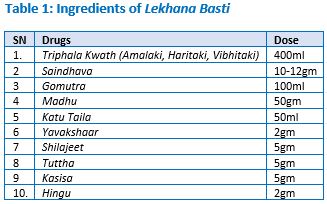Effect of Virechana Karma and Basti in the management of Sthaulya - A Case Study
Keywords:
Sthaulya, Medovridhi, Lekhana Basti, VirechanaAbstract
Sthaulya (obesity) is a predominant metabolic disorder, which is described by Charaka in Ashtaunindita Purusha. Sedentary life, lack of exercise, faulty food habits, urbanization, psychological factors along with genetic predisposition play a major role in the aetiopathogenesis of Sthaulya. Females are more prone to obesity due to feminine factors like menopause and aggravating factors like delivery, I.U.C.D., O.C.P, and miscarriage. Being overweight and Obesity contributes to Diseases like Heart attacks, stroke, arteriosclerosis, Diabetes, Mental Retardation/affection like Mood swings, and even depression. According to the Ayurvedic text, Sthaulya is caused due to Medovriddhi which includes an abnormal and excessive accumulation of Medodhatu in the body. In the Sthaulya etiological factors mainly vitiate the Meda-Kapha. This vitiated Meda obstructs the path of Vata, which results in the provocation of Vata. In the Samprapti of Sthaulya, two factors are of prime importance, Tikshna Jatharagni, and Medodhatvagnimandya. Irrationality between two levels of Agni makes the disease Krichha Shadhya, but Panchkarma therapy can give a better solution for this problem. So, treatment modality should be planned considering vitiated Meda, Kapha, and Vata. Lekhana Basti and Virechana Karma are selected for the management of Sthaulya.
Downloads
References
Shastri K.N. Ashtoninditiya Sutra 21/4. In: Charaka Samhita of Agnivesha. Varanasi: Chaukhambha Bharti Academy; 2013. p.no.408.
Shastri K.N. Santarpaniya Sutra 23/6. In: Charaka Samhita of Agnivesha. Varanasi: Chaukhambha Bharti Academy; 2013. p.no.436.
Shastri K.N. Ashtoninditiya Sutra 21/3. In: Charaka Samhita of Agnivesha. Varanasi: Chaukhambha Bharti Academy; 2013. p.no.407.
Shastri K.N. Ashtoninditiya Sutra 21/9. In: Charaka Samhita of Agnivesha. Varanasi: Chaukhambha Bharti Academy; 2013. p.no.411.
World Health Organization (WHO). Obesity: preventing and managing the global epidemic. Report of a WHO consultation. (1-253). World Health Organ Tech Rep Ser. 2000;p.894:i–xii. [PubMed]
BMI classification”. Global Database on Body Mass Index. WHO. 2006.
Shastri K.N. Ashtoninditiya Sutra 21/20. In: Charaka Samhita of Agnivesha. Varanasi: Chaukhambha Bharti Academy; 2013. p.no.414.
Gupt K.A. Dvividhaupkarmaniya Sutra 14/12. In: Ashtanga Hridyayam of Vaghbhata. Varanasi: Chaukhambha Prakashana; 2018. p.no.136.
Shastri KA. Niruhakrama Chikitsa 38/82. In: Sushruta Samhita of Maharshi Sushruta Dalhana. Varanasi: Chaukhambha Sanskrit Sansthan; 2014. p.no.214.
Shastri K.N. Santarpaniya Sutra 23/8. In: Charaka Samhita of Agnivesha. Varanasi: Chaukhambha Bharti Academy; 2013. p.no.437.
Shastri K.N. Ashtoninditiya Sutra 21/4. In: Charaka Samhita of Agnivesha. Varanasi: Chaukhambha Bharti Academy; 2013. p.no.408.
Shastri K.N. Kalpana Siddhi Adhyaya 1/47-48 In: Charaka Samhita of Agnivesha. Varanasi: Chaukhambha Bharti Academy; 2013. p.no.973.
Gupt K.A. Dravadravyavijaniya Sutra 5/56. In: Ashtanga Hridyayam of Vaghbhata. Varanasi: Chaukhambha Prakashana; 2018. p.no.59.
Shastri K.A. Doshadhatumalakshyavridhi Sutra 15/7. In: Sushruta Samhita of Maharshi Sushruta. Varanasi: Chaukhambha Sanskrit Sansthan; 2014. p.no.75.















